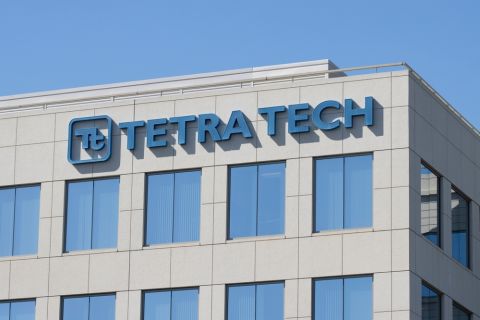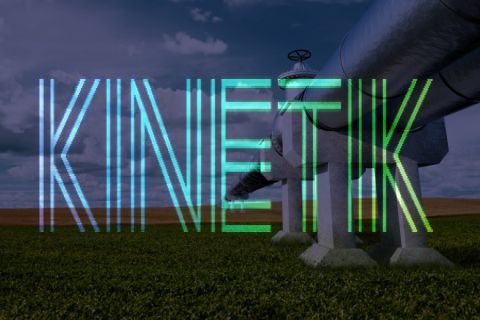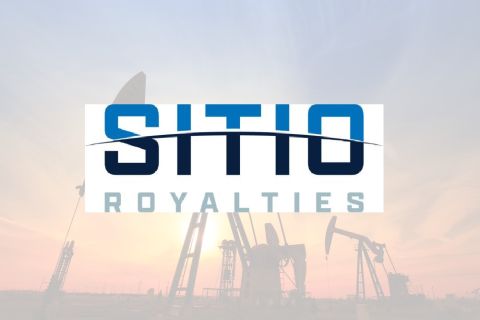
After closing, Exxon’s Permian production volume will more than double to 1.3 Mboe/d, based on 2023 volumes. (Source: Shutterstock)
Exxon Mobil Corp. is seeking greater drilling efficiency—and lower drilling costs—in the Midland Basin with its massive acquisition of Pioneer Natural Resources.
The all-stock deal, valued at $60 billion excluding Pioneer’s net debt, combines Pioneer’s more than 850,000 net acres in the core of the Midland Basin with Exxon's 570,000 net Permian acres.
The transaction represents the Spring, Texas-based supermajors’ largest acquisition since Exxon’s merger with Mobil in 1999.
After closing, Exxon’s Permian production volume will more than double to 1.3 Mboe/d, based on 2023 volumes; output is expected to increase to approximately 2 Mboe/d in 2027.
By combining Irving, Texas-based Pioneer’s leading basin position and Exxon’s technology and development expertise, the combined company will aim to achieve about $2 billion in annual synergies over the coming decade.
Around $700 million in annual savings are expected to be realized through a roughly 15% decrease in total development costs, Exxon said.
Of that total, around $400 million per year will come from applying Exxon’s drilling capabilities and cube well design; $200 million per year will come from drilling longer laterals to reduce the overall number of wells; $100 million per year will derive from G&A cost savings.
Another $1.3 billion per year will come from the approximately 1 Bboe in additional resource Exxon is confident it can recover with existing technologies and development practices.
“It does not include the pipeline of new technologies that are either in the early stages of deployment or close to deployment,” Exxon Senior Vice President Neil Chapman said during the company’s third-quarter earnings call with analysts.
“By applying what we’ve already demonstrated, we’re confident we can recover an additional 1 billion oil-equivalent barrels, more than either Pioneer or industry could have demonstrated with their existing performance,” he said.
RELATED
Exxon Acquiring Pioneer for $60B as Permian Oil Takes Center Stage
Cube development
One reason Exxon is confident in achieving greater drilling efficiencies with Pioneer’s Midland Basin position is the supermajor’s cube development strategy.
For several years, Exxon has been fine-tuning its cube development strategy in the Permian—a process in which multiple horizontal wells are drilled in stacked intervals from a single surface location.
The company began developing cube wells in the Permian to avoid parent-child well interference, a phenomenon where secondary wells placed too close to initial wells tap into flows for the first well, diminishing overall returns.
In recent years, Exxon, Pioneer and several other Permian operators have shifted well spacing and subsurface designs to adhere to cube development strategies.
Since drilling its first cubes in the Permian around late 2017, Exxon says its development strategy in the Permian is working.
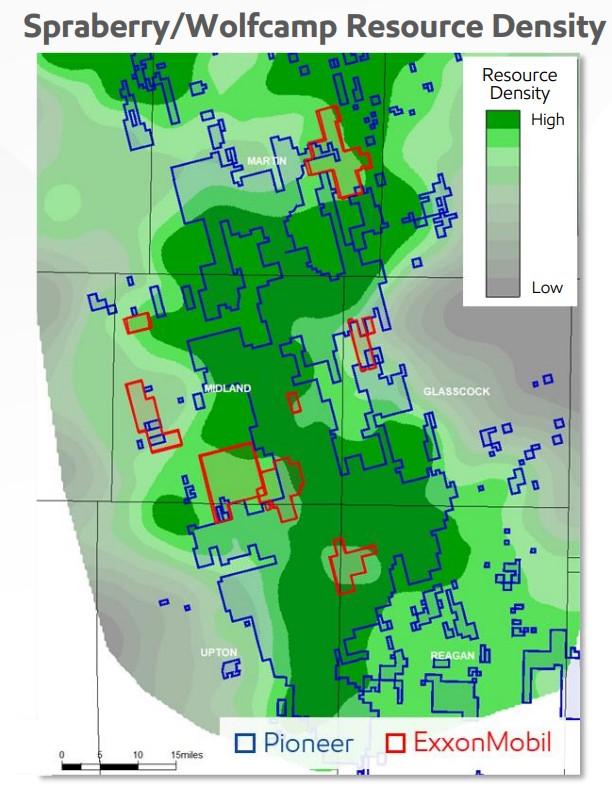
As of 2022, both Exxon and Pioneer were exclusively developing cube wells on their respective positions in the Midland Basin. However, Exxon’s Midland portfolio is considerably less quality than Pioneer’s own position in the Midland when it comes to resource density.
Despite Pioneer’s more advantaged acreage position and resource base, Exxon has essentially equivalent recovery rates in the Midland as Pioneer.
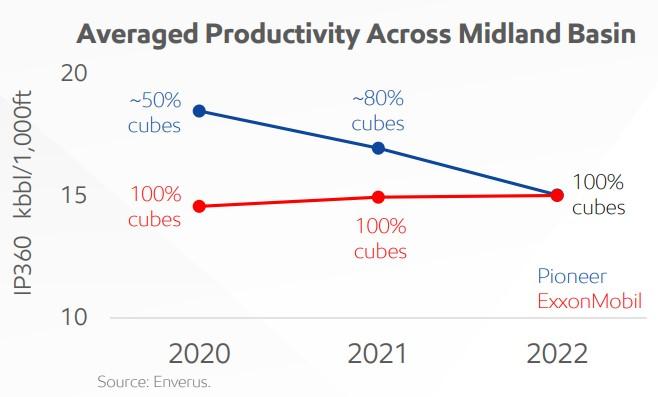
Exxon’s outlook is even better when it comes to comparable acreage and resource quality.
Comparing adjacent 10,000-ft-lateral cube wells in Martin County, Texas, Exxon’s cubes are delivering around a 20% higher recovery compared to Pioneer and other Midland Basin E&Ps.
“It’s not just about how you deliver cubes,” Chapman said. “When you’ve got better recovery, when you’ve got better capital efficiency, it gives access to economically developing what we would describe as secondary benches.”
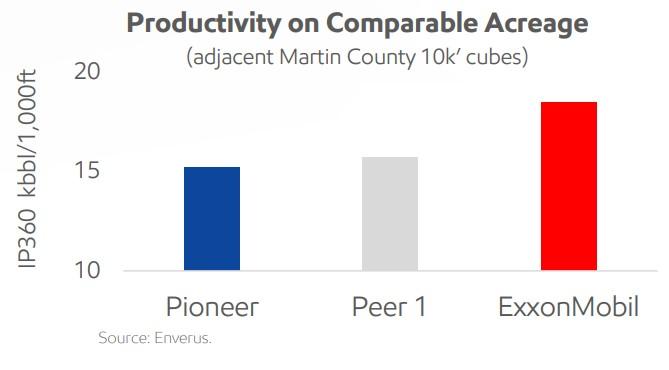
RELATED
$60B Pioneer Deal ‘Completely Different’ from XTO Takeover
Profits fall
Earnings for Exxon Mobil Corp. and its fellow U.S. supermajor Chevron Corp. fell drastically in the third quarter after the oil giants raked in record profits during the same period the year before.
Exxon brought in third-quarter earnings of $9.1 billion, or $2.25 per share, the Spring, Texas-based major reported before markets opened on Oct. 27.
That’s down over 50% from the same quarter a year ago, when Exxon raked in record earnings of $19.7 billion, or $4.68 per share.
Chevron reported third-quarter earnings of $6.5 billion, or $3.48 per share, the morning of Oct. 27.
The California-based major’s earnings fell nearly 40% compared to last year, when Chevron brought in earnings of $11.2 billion, or $5.78 per share, during the same period.
Both companies cited headwinds from commodity prices and refining margins as weighing on quarterly profitability. Analysts had anticipated the sharp drops in earnings by both majors.
RELATED
Recommended Reading
Magnolia Bolts-on 27,000 Acres in South Texas’ Giddings Field
2024-05-09 - Magnolia Oil & Gas said it paid $125 million to a private operator to acquire the acreage, which has minimal production.
Tetra Tech Acquires Convergence Controls & Engineering
2024-05-09 - Tetra Tech is acquiring Convergence Controls & Engineering to expand its digital water and energy offerings.
Kinetik Launches Delaware Basin M&A Valued at $1.3B
2024-05-09 - Kinetik Holdings will buy Durango Permian infrastructure for $765 million, excluding contingency payments, and sell its interests in the Gulf Coast Express pipeline to AcrLight Capital Partners for $540 million.
Chord Juggles Closing $4B Enerplus Deal, Plans to Drill 4-mile Laterals
2024-05-09 - Chord Energy expects to close its Enerplus acquisition by the end of May but, for now, is focused on three-mile and, eventually, four-mile laterals in the Williston Basin.
Sitio Closes D-J Basin Deal, Looks to Defragment Minerals Space
2024-05-09 - Sitio Royalties closed its acquisition of 13,062 net royalty acres. CEO Chris Conoscenti has a strong pipeline of minerals acquisition opportunities.


